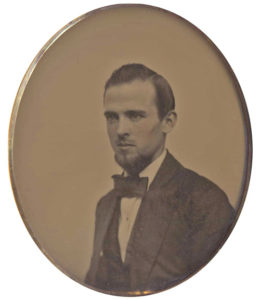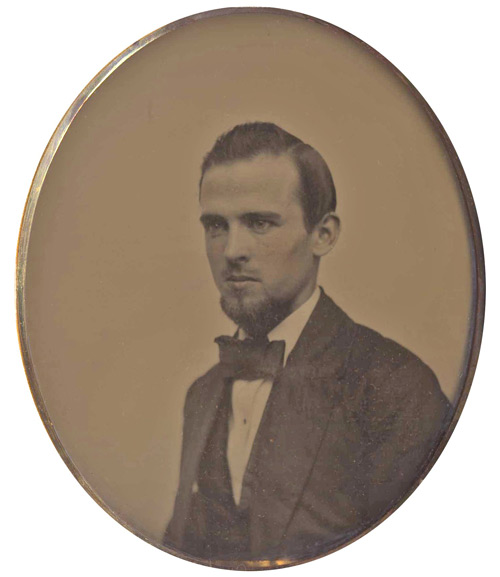By Trip Wiggins
b. 31 Aug 1836/The Meadows (Eastern View), Fauquier Co., VA
d. Apr 1918/Norfolk, VA (lived there for 25 years – seat for the Southern Va Diocese)
13th St. George’s Rector
At St George’s: Oct. 1858 – Nov. 1862
Assistant Rector summer 1858
“acting” Rector Oct 1858 until ordained priest in 1860
Married: 27 Apr 1859/Fredericksburg; Sarah “Sallie” Griffith Hoxton; had 6 children
College of William & Mary – grad. 1855<
Virginia Theological Seminary – grad. 1858 (our first seminary graduate)
[He later received honorary doctorates from William and Mary College in 1876, Washington and Lee University in 1887, and the University of the South in 1902.]
Deacon – 1858, Priest – Nov 1860 (at St. George’s), Bishop - 1883
Parishes:
St. George’s/Fredericksburg, VA 1858-1862 (first as McGuire’s assistant, then as rector)
Chaplain in the CSA first in the former “Stonewall” Division (1863) then at Danville, VA (1864-65)
Roanoke Parish in Halifax County, VA 1865 (following the war)
Christ Church/Alexandria, VA 1866
Emmanuel Church, Baltimore, MD 1867-1883
Consecrated assistant bishop of the Diocese of Virginia October 31, 1883- Sep. 1892
First Bishop of the Diocese of Southern Virginia when the diocese of Virginia separated into two dioceses in Sep. 1892- Apr. 1918 (his death)
While rector at St. George’s…
Officiated at the burial of the 51 Confederate soldiers interred in the Potter’s Field in Fredericksburg in 1862. Left following the Battle of Fredericksburg, Dec 1862

Alfred Magill Randolph was a Virginian through and through. Born August 31, 1836 at “The Meadows” near Winchester, VA, he was an 8th generation Virginian – his immigrant ancestor arriving in Virginia in 1674. Per family tradition, he was schooled at the College of William and Mary, graduating in 1855. He was noted as an eloquent speaker in college. He then moved to the Virginia Theological Seminary in Alexandria where he graduated as a Deacon in 1858 and was hired by Rev. Edward C. McGuire at St. George’s as his assistant as McGuire was in deteriorating health. Upon McGuire’s death in October, 1858, the Vestry hired the young deacon as our new rector. He was ordained priest in 1860 and fully assumed his duties.
In 1859 he also started his family, marrying Sarah “Sallie” Griffith Hoxton in Fredericksburg in April of that year. Sallie’s father was the associate principal of the Episcopal High School – so they probably met in Alexandria while he was a student.
By 1861 the war was at the doorstep of Fredericksburg and the Union army occupied the town in the spring of 1862. According to a Union colonel who attended services in St. George’s on Sunday, May 18, 1862, Randolph omitted the prayer for the president of the United States. The officer admitted that the clergyman had failed to pray for the president of the Confederate States, but he attributed this omission to the United States officers in the congregation and the northern troops in the town. Randolph conducted regular services in St. George’s up to and including, Sunday, November 17, 1862.
In preparation for the battle of Fredericksburg all non-combatants were commanded to leave the city between 9 P.M. November 21, and 5 A.M. the following morning. In compliance with this order Mr. and Mrs. Randolph and their day-old baby left town about midnight in an ambulance. They passed through the Confederate Army as it was moving into position. In the late spring of 1863 Randolph entered the Confederate Army as a chaplain and served for about a year with what had been “Stonewall’” Jackson’s Corps. Then he was later transferred to the post chaplaincy at Danville, where he remained until the close of hostilities. The vestry of St. George’s accepted Randolph’s resignation on April 24, 1865.
Following the war he initially accepted the charge of Roanoke Parish in Halifax County for six months then accepted a call in 1866 to Christ Church, Alexandria. In 1867 he moved to the rectorship of Emmanuel Church, Baltimore, where he remained until his election as assistant bishop of the diocese of Virginia fifteen years later. Baltimore was loathe to lose Randolph as in addition to his vast labors as Emmanuel’s preacher and pastor, his mid-week lectures on the Bible drew to his church a “large congregation of the most cultivated people” in the city. He served as assistant bishop from 1883 to September 18, 1892, and then as bishop of the newly established diocese of Southern Virginia when the diocese of Virginia split. A staunch foe of “High Churchism and Ritualism” and an avid Low churchman, Randolph came within three months of completing sixty years in the ministry. He delivered the Bishop Paddock lectures at the General Theological Seminary in New York City during the winter on 1901-1902, and they were published as Reason, Faith and Authority in Christianity.
He died on April 6, 1918, in Norfolk, VA (the seat of the diocese). His wife followed him five years later. Both are buried in Hollywood Cemetery in Richmond. To date he is the only St. Georgian to become a bishop.
Sources:
Quenzel, Carrol. The History and Background of St George’s Episcopal Church Fredericksburg, Virginia (1951)
St. George’s Vestry Minutes
Various local newspaper articles (CRRL)
St. George’s History Pages on the Internet
https://en.wikipedia.org/wiki/Alfred_Magill_Randolph
Diocese of Virginia. “Meet Me in Galilee…Beginning the Journey From Repentance to Reconciliation: A History of Racism and Race in the Diocese of Virginia.” (2012)
